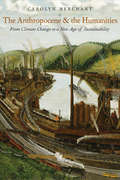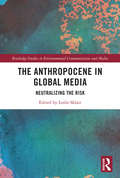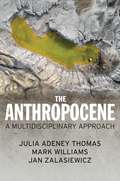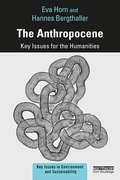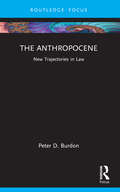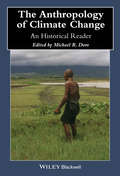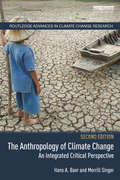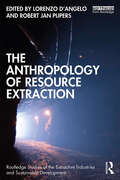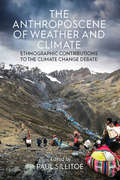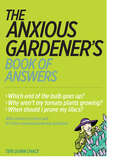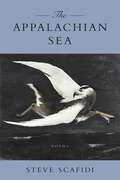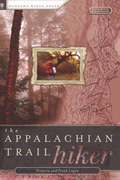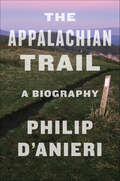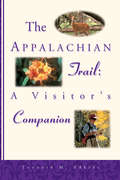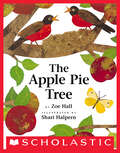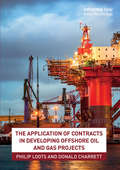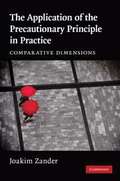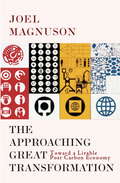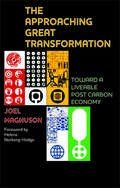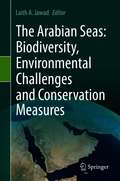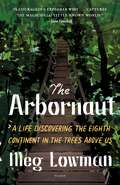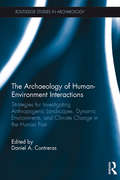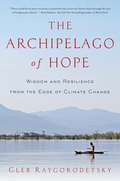- Table View
- List View
The Anthropocene and the Humanities: From Climate Change to a New Age of Sustainability (The Future Series)
by Carolyn MerchantA wide-ranging and original introduction to the Anthropocene that offers fresh, theoretical insights bridging the sciences and the humanities From noted environmental historian Carolyn Merchant, this book focuses on the original concept of the Anthropocene first proposed by Paul Crutzen and Eugene Stoermer in their foundational 2000 paper. It undertakes a broad investigation into the ways in which science, technology, and the humanities can create a new and compelling awareness of human impacts on the environment. Using history, art, literature, religion, philosophy, ethics, and justice as the focal points, Merchant traces key figures and developments in the humanities throughout the Anthropocene era and explores how these disciplines might influence sustainability in the next century. Wide-ranging and accessible, this book from an eminent scholar in environmental history and philosophy argues for replacing the Age of the Anthropocene with a new Age of Sustainability.
The Anthropocene in Global Media: Neutralizing the risk (Routledge Studies in Environmental Communication and Media)
by Leslie SklairThis book offers the first systematic study of how the ‘Anthropocene’ is reported in mass media globally, drawing parallels between the use (or misuse) of the term and the media’s attitude towards the associated issues of climate change and global warming. Identifying the potential dangers of the Anthropocene provides a useful path into a variety of issues that are often ignored, misrepresented, or sidelined by the media. These dangers are widely discussed in the social sciences, environmental humanities, and creative arts, and this book includes chapters on how the contributions of these disciplines are reported by the media. Our results suggest that the natural science and mass media establishments, and the business and political interests which underpin them, tend to lean towards optimistic reassurance (the ‘good’ Anthropocene), rather than pessimistic alarmist stories, in reporting the Anthropocene. In this volume, contributors explore how dangerous this ‘neutralizing’ of the Anthropocene is in undermining serious global action in the face of the potential existential risks confronting humanity. The book presents results from media in more than 100 countries in all major languages across the globe. It covers the reporting of key environmental issues, such as the impact of climate change and global warming on oceans, forests, soil, biodiversity, and the biosphere. We offer explanations for differences and similarities in how the media report the Anthropocene in different regions of the world. In doing so, the book argues that, though it is still controversial, the idea of the Anthropocene helps to concentrate minds and behaviour in confronting ongoing ecological (and Coronavirus) crises. The Anthropocene in Global Media will be of interest to students and scholars of environmental studies, media and communication studies, and the environmental humanities, and all those who are concerned about the survival of humans on planet Earth.
The Anthropocene: A Multidisciplinary Approach
by Julia Adeney Thomas Jan ZalasiewiczHumans rank with the powerful forces of nature transforming Earth. Since the mid-20th century, population growth, industrialization, and globalization have had such deep and wide-ranging impacts that our planet no longer functions as it did during the previous eleven millennia. So distinctive is this collective human intervention that a new geological interval has been proposed; it is called the Anthropocene. The Anthropocene is intriguing scientifically, fascinating intellectually, and deeply disturbing politically, socially, economically, and ethically. We must learn how to co-exist sustainably with the rest of nature in what is emerging as a new planetary state. To do so, we must first understand what "Anthropocene" means in all its dimensions. This book adopts a multidisciplinary approach, starting with an exploration of the Anthropocene as a geological concept: ranging across the physical changes to the landscape, to the rapidly heating climate, to a biosphere undergoing transformation. And what of the "anthropos" in the Anthropocene? While geoscience does not normally address political and ethical issues of justice and equity, or economics and culture, Anthropocene studies in the humanities and social sciences investigate the complexities of the human activity driving global change. Here the book looks at human history, both in the deep past and more recently, the politics and economics of growth spurring the Anthropocene, and potential ways of mitigating its cruel effects. Our fragile, still beautiful, planet is finite. The new realities of the Anthropocene will need our best efforts, across disciplinary divides, at effective hope and action.
The Anthropocene: Key Issues for the Humanities (Key Issues in Environment and Sustainability)
by Eva Horn Hannes BergthallerThe Anthropocene is a concept which challenges the foundations of humanities scholarship as it is traditionally understood. It calls not only for closer engagement with the natural sciences but also for a synthetic approach bringing together insights from the various subdisciplines in the humanities and social sciences which have addressed themselves to ecological questions in the past. This book is an introduction to, and structured survey of, the attempts that have been made to take the measure of the Anthropocene, and explores some of the paradigmatic problems which it raises. The difficulties of an introduction to the Anthropocene lie not only in the disciplinary breadth of the subject, but also in the rapid pace at which the surrounding debates have been, and still are, unfolding. This introduction proposes a conceptual map which, however provisionally, charts these ongoing discussions across a variety of scientific and humanistic disciplines. This book will be essential reading for students and researchers in the environmental humanities, particularly in literary and cultural studies, history, philosophy, and environmental studies.
The Anthropocene: New Trajectories in Law (New Trajectories in Law)
by Peter D. BurdonThis book introduces the concept of the Anthropocene and examines its importance for environmental legal thinking, research and practice. Two main arguments are explored. The first is that much of the scholarship in environmental law that addresses the Anthropocene does not respond to Earth systems science or the difference in scale as we move from local to global systems. Key examples include a focus on anthropocentrism, attempts to constitutionalise environmental protections, the prevalence of legal rights and the idea of ecological integrity. The second argument is that these points of focus derive from the prevalence of idealism in environmental legal scholarship. Idealism in this context does not refer to naivety or the presentation of unrealistic goals. Rather, this book is concerned with idealism as a philosophical commitment to the power of ideas to determine reality and drive future change. As expressed in legal scholarship, this book also argues that idealism involves an abstraction from material reality and a refusal to directly engage those forces that have given rise to the Anthropocene. In response, this book uses a method of critique to uncover the presumptions and presuppositions that underlie environmental scholarship. As a counter to idealism, it also sketches out a framework for materialism in the Anthropocene. This book’s engagement with these questions will appeal to undergraduate and postgraduate students in law, politics, philosophy or the ecological humanities. It will also be of interest to academics in these disciplines and libraries around the world.
The Anthropocenic Turn: The Interplay between Disciplinary and Interdisciplinary Responses to a New Age (Routledge Interdisciplinary Perspectives on Literature)
by Gabriele Dürbeck Philip HüpkesThis interdisciplinary volume discusses whether the increasing salience of the Anthropocene concept in the humanities and the social sciences constitutes an "Anthropocenic turn." The Anthropocene discourse creates novel conceptual configurations and enables scholars to re-negotiate and re-contextualize long-established paradigms, premises, theories and methodologies. These innovative constellations stimulate fresh research in many areas of thought and practice. The contributors to this volume respond to the proposition of an "Anthropocene turn" from the perspective of diverse research fields, including history of science, philosophy, environmental humanities and political science as well as literary, art and media studies. Altogether, the collection reveals to which extent the Anthropocene concept challenges deep-seated assumptions across disciplines. It invites readers to explore the wealth of scholarly perspectives on the Anthropocene as well as unexpected inter- and transdisciplinary connections.
The Anthropology of Climate Change: An Historical Reader (Wiley Blackwell Anthologies in Social and Cultural Anthropology)
by Michael R. DoveThis timely anthology brings together for the first time the most important ancient, medieval, Enlightenment, and modern scholarship for a complete anthropological evaluation of the relationship between culture and climate change. Brings together for the first time the most important classical works and contemporary scholarship for a complete historical anthropological evaluation of the relationship between culture and climate change Covers the historic and prehistoric records of human impact from and response to prior periods of climate change, including the impact and response to climate change at the local level Discusses the impact on global debates about climate change from North-South post-colonial histories and the social dimensions of the science of climate change. Includes coverage of topics such as environmental determinism, climatic events as social catalysts, climatic disasters and societal collapse, and ethno-meteorology An ideal text for courses in climate change, human/cultural ecology, environmental anthropology and archaeology, disaster studies, environmental sciences, science and technology studies, history of science, and conservation and development studies
The Anthropology of Climate Change: An Integrated Critical Perspective (Routledge Advances in Climate Change Research)
by Merrill Singer Hans A. BaerIn addressing the urgent questions raised by climate change, this book provides a comprehensive overview of the anthropology of climate change, guided by a critical political ecological framework. It examines the emergence and slow maturation of the anthropology of climate change, reviews the historic foundations for this work in the archaeology of climate change, and presents three alternative contemporary theoretical perspectives in the anthropology of climate change. This second edition is fully updated to include the most recent literature published since the first edition in 2014. It also examines a number of new topics, including an analysis of the 2014 American Anthropological Association’s Global Climate Change Task Force report, a new case study on responses to climate change in developed societies, and reference to the stance of the Trump administration on climate change. Not only does this book provide a valuable overview of the field and the key literature, but it also gives researchers and students in Environmental Anthropology, Climate Change, Human Geography, Sociology, and Political Science a novel framework for understanding climate change that emphasizes human socioecological interactions.
The Anthropology of Resource Extraction (Routledge Studies of the Extractive Industries and Sustainable Development)
by Lorenzo D’AngeloThis book offers an overview of the key debates in the burgeoning anthropological literature on resource extraction. Resources play a crucial role in the contemporary economy and society, are required in the production of a vast range of consumer products and are at the core of geopolitical strategies and environmental concerns for the future of humanity. Scholars have widely debated the economic and sociological aspects of resource management in our societies, offering interesting and useful abstractions. However, anthropologists offer different and fresh perspectives – sometimes complementary and at other times alternative to these abstractions – based on field researches conducted in close contact with those actors (individuals as well as groups and institutions) that manipulate, anticipate, fight for, or resist the extractive processes in many creative ways. Thus, while addressing questions such as: "What characterizes the anthropology of resource extraction?", "What topics in the context of resource extraction have anthropologists studied?", and "What approaches and insights have emerged from this?", this book synthesizes and analyses a range of anthropological debates about the ways in which different actors extract, use, manage, and think about resources. This comprehensive volume will serve as a key reading for scholars and students within the social sciences working on resource extraction and those with an interest in natural resources, environment, capitalism, and globalization. It will also be a useful resource for practitioners within mining and development.
The Anthroposcene of Weather and Climate: Ethnographic Contributions to the Climate Change Debate
by Paul SillitoeWhile it is widely acknowledged that climate change is among the greatest global challenges of our times, it has local implications too. This volume forefronts these local issues, giving anthropology a voice in this great debate, which is otherwise dominated by natural scientists and policy makers. It shows what an ethnographic focus can offer in furthering our understanding of the lived realities of climate debates. Contributors from communities around the world discuss local knowledge of, and responses to, environmental changes that need to feature in scientifically framed policies regarding mitigation and adaptation measures if they are to be effective.
The Anxious Gardener's Book of Answers
by Teri Dunn ChaceThe Anxious Gardener's Book of Answers identifies the 100 most common gardening mistakes and gives gardeners the techniques to prevent them. Or, if it's too late and they've already goofed, there are tips to fix the mistake. The book's 24 chapters tackle every kind of gardening disaster, whether it has to do with plants, tools and techniques, or general care and maintenance. Gardeners looking to prune their roses will learn to hold off until late winter to avoid damaging plant tissue. Gardeners that have allowed their mint to overgrow? Dunn advises pulling it out and replanting it in a container to control the root. Organized by common garden topics and designed to be easily dipped in and out of, The Anxious Gardener's Book of Answers offers nuggets of wisdom based on Teri Dunn Chace's years of hands-on gardening experience. Advice is humorously supported by Colleen Coover's delightful illustrations. This accessible guide will transform an anxious gardener into an informed, confident, successful gardener with a mistake-free garden
The Appalachian Sea: Poems (Southern Messenger Poets)
by Steve ScafidiSteve Scafidi’s The Appalachian Sea explores the eponymous place of mountains and story, of rivers and magic, as well as of mortality, where people work and live and die. What began as an homage to the American painter Miles Cleveland Goodwin became a celebration of the spectral qualities of place and home. The artist’s gothic imagery of haints and dark orchards haunts the book, wherein the Shenandoah wends, old farmers toil, and ghosts wander a land where change comes on like a flood. There is no escape from this spilling river, the “Appalachian sea,” yet for a while we get by and survive. These poems sing of the temporary persistence that makes what surrounds us beloved and strange.
The Appalachian Trail Hiker
by Frank Logue Victoria LogueThe Appalachian Trail Hiker is a one-stop guide to preparing for and hiking the A.T. Although primarily geared to prepare and sustain the intrepid thru hiker, the book is also a must-have for anyone who wishes to experience the A.T., whether for an hour or for six months.
The Appalachian Trail: A Biography
by Philip D'AnieriThe Appalachian Trail is America&’s most beloved trek, with millions of hikers setting foot on it every year. Yet few are aware of the fascinating backstory of the dreamers and builders who helped bring it to life over the past century. The conception and building of the Appalachian Trail is a story of unforgettable characters who explored it, defined it, and captured national attention by hiking it. From Grandma Gatewood—a mother of eleven who thru-hiked in canvas sneakers and a drawstring duffle—to Bill Bryson, author of the best-selling A Walk in the Woods, the AT has seized the American imagination like no other hiking path. The 2,000-mile-long hike from Georgia to Maine is not just a trail through the woods, but a set of ideas about nature etched in the forest floor. This character-driven biography of the trail is a must-read not just for ambitious hikers, but for anyone who wonders about our relationship with the great outdoors and dreams of getting away from urban life for a pilgrimage in the wild.
The Appalachian Trail: A Visitor's Companion
by Leonard AdkinsA comprehensive naturalist's guide to the Appalachian Trail, the Visitor's Companion contains all the essential information about the AT - from the trail's fascinating history to detailed information on the geology, trees, flowers, birds, amphibians, reptiles, and mammals of the Appalachian Mountains.
The Apple Pie Tree
by Zoe HallWe have a special tree in our yard -- an apple pie tree!Colorful collage illustrations follow each season as an apple tree grows leaves, fragrant blossoms, and tiny green apples. Soon the fruit is big, red, and ready to be picked. It's time to make an apple pie! Here is a celebration of apples and how things grow -- sure to delight young readers all year long.
The Application of Contracts in Developing Offshore Oil and Gas Projects
by Philip Loots Donald CharrettThis book provides a comprehensive overview of the key aspects and contracts involved in the process of developing oil and gas projects, with an emphasis on offshore developments. Project development in oil and gas carries with it numerous unique risks and challenges. By identifying and managing risk through the various contract stages, each stage of the project is seen in perspective and therefore gives readers a better understanding of how that stage was arrived at and what is expected to come later. To do this, the authors use illustrative international case studies from past and current projects, thereby deepening the reader’s understanding and awareness of risk from practical experience, as well as suggesting answers for those who are involved in developing oil and gas projects. The Application of Contracts in Developing Offshore Oil and Gas Projects is intended for project owners, project managers, contractors, finance managers, commercial managers and lawyers who seek to understand the subject from a practical point of view.
The Application of the Precautionary Principle in Practice
by Joakim ZanderThis overview of the role played by the precautionary principle in international trade law, European law and national law compares how precautionary considerations have been applied in the fields of pesticide regulation and the regulation of base stations for mobile telephones in Sweden, the UK and the US. A number of problems in the current application of the precautionary principle are identified and discussed. For example, it is shown that a firm reliance on a wide and open-ended precautionary principle may lead to problems with the consistency, foreseeability, effectiveness and efficiency of measures intended to reduce environmental or health risks. It is suggested that the precautionary principle indeed may be an important tool, but that in order to be acceptable it must be coupled with strong requirements on the performance of risk assessments, cost/benefit analyses and risk trade-off analyses.
The Approaching Great Transformation
by Joel Magnuson Helena Norberg-HodgeHow should we act and think economically in the world as the era of cheap oil comes to an end? The Approaching Great Transformation begins to answer this massive question, focusing on the people and communities already at work on the transition: energy descent pioneers in the UK and the US educating their communities about the road ahead, small enterprises defying traditional "profit" in favor of permanence and sustainability, and cities preparing for a post carbon future.Highlighting the work of thinkers like John Ruskin and E. F. Schumacher, Magnuson here builds on his previous book, Mindful Economics. is already being done. The Approaching Great Transformation extends the ideas put forth in Magnuson's previous book,Mindful Economics, and features a foreword by Helena Noberg-Hodge.
The Approaching Great Transformation: Toward a Liveable Post Carbon Economy
by Joel MagnusonJoel Magnuson's visionary insights into the decline of the Oil Age and life afterward combine sobering warnings with genuine hope. The facts are hard: global oil deposits will soon peak if they haven't already and the violent race to secure what's left has already begun. Meanwhile, our culture of consumption continues its heedless dependence on this and other scarce and fast-disappearing resources including other fossil fuels, water, topsoil, and basic metals. The consequences won't just be expensive gasoline. The very nature of life as we've come to know it will change and Magnuson explains how compounding factors like global warming, skyrocketing debt, and ill-prepared governments stand to turn this inevitable change into a needless catastrophe. But the hope is real: individuals and communities around the world have already begun taking action to shift away from consumer culture. Drawing on the visionary work of E.F. Schumacher, John Ruskin, and other pioneering thinkers, Magnuson argues that mindful and concerted action can shape the future. With an emphasis on current transitional projects like B Corporations and LETS projects, he shows that the true great transformation is already underway and it's up to us to continue it. With a foreword by Helena Norberg-Hodge, founder and director of the International Society for Ecology and Culture (ISEC)
The Arabian Seas: Biodiversity, Environmental Challenges and Conservation Measures
by Laith A. JawadThe Arabian Seas Marine Region encompasses marine areas from Djibouti to Pakistan, including the northern part of Somalia, the Red Sea, the Arabian/Persian Gulf, and parts of the Arabian Sea. Human pressures on the coastal and marine environments are evident throughout the region, and have resulted in harmful environmental effects. Oil and domestic, urban and industrial pollutants in several areas of this part of the world have caused local habitat degradation, eutrophication and algal blooms. Further, coastal landfill, dredging, and sedimentation, as well as nutrient and sediment runoff from phosphate mining, agriculture and grazing, and reduction in freshwater seepage due to groundwater extraction are all contributing to the degradation of coastal environments. This book discusses aspects not covered in other books on the region, which largely focus on marine biodiversity, and examines several environmental challenges that are often ignored, but which have a significant impact on the environment. Evaluating the status quo, it also recommends conservation measures and examines the abiotic factors that play a major main role in the environmental changes. Lastly, the book addresses the biodiversity of the area, providing a general context for the conservation and management measures discussed.
The Arbornaut: A Life Discovering the Eighth Continent in the Trees Above Us
by Meg Lowman“An eye-opening and enchanting book by one of our major scientist-explorers.” —Diane Ackerman, author of The Zookeeper’s WifeNicknamed the “Real-Life Lorax” by National Geographic, the biologist, botanist, and conservationist Meg Lowman—aka “CanopyMeg”—takes us on an adventure into the “eighth continent” of the world's treetops, along her journey as a tree scientist, and into climate actionWelcome to the eighth continent!As a graduate student exploring the rain forests of Australia, Meg Lowman realized that she couldn’t monitor her beloved leaves using any of the usual methods. So she put together a climbing kit: she sewed a harness from an old seat belt, gathered hundreds of feet of rope, and found a tool belt for her pencils and rulers. Up she went, into the trees. Forty years later, Lowman remains one of the world’s foremost arbornauts, known as the “real-life Lorax.” She planned one of the first treetop walkways and helps create more of these bridges through the eighth continent all over the world. With a voice as infectious in its enthusiasm as it is practical in its optimism, The Arbornaut chronicles Lowman’s irresistible story. From climbing solo hundreds of feet into the air in Australia’s rainforests to measuring tree growth in the northeastern United States, from searching the redwoods of the Pacific coast for new life to studying leaf eaters in Scotland’s Highlands, from conducting a BioBlitz in Malaysia to conservation planning in India and collaborating with priests to save Ethiopia’s last forests, Lowman launches us into the life and work of a field scientist, ecologist, and conservationist. She offers hope, specific plans, and recommendations for action; despite devastation across the world, through trees, we can still make an immediate and lasting impact against climate change. A blend of memoir and fieldwork account, The Arbornaut gives us the chance to live among scientists and travel the world—even in a hot-air balloon! It is the engrossing, uplifting story of a nerdy tree climber—the only girl at the science fair—who becomes a giant inspiration, a groundbreaking, ground-defying field biologist, and a hero for trees everywhere.Includes black-and-white illustrations
The Archaeology of Human-Environment Interactions: Strategies for Investigating Anthropogenic Landscapes, Dynamic Environments, and Climate Change in the Human Past (Routledge Studies in Archaeology)
by Daniel A. ContrerasThe impacts of climate change on human societies, and the roles those societies themselves play in altering their environments, appear in headlines more and more as concern over modern global climate change intensifies. Increasingly, archaeologists and paleoenvironmental scientists are looking to evidence from the human past to shed light on the processes which link environmental and cultural change. Establishing clear contemporaneity and correlation, and then moving beyond correlation to causation, remains as much a theoretical task as a methodological one.This book addresses this challenge by exploring new approaches to human-environment dynamics and confronting the key task of constructing arguments that can link the two in concrete and detailed ways. The contributors include researchers working in a wide variety of regions and time periods, including Mesoamerica, Mongolia, East Africa, the Amazon Basin, and the Island Pacific, among others. Using methodological vignettes from their own research, the contributors explore diverse approaches to human-environment dynamics, illustrating the manifold nature of the subject and suggesting a wide variety of strategies for approaching it. This book will be of interest to researchers and scholars in Archaeology, Paleoenvironmental Science, Ecology, and Geology.
The Archaeology of Mediterranean Landscapes
by Kevin WalshFunded by the European Union, the Populus project is a major study of long-term change in Mediterranean Europe involving a multidisciplinary team of archaeologists, palaeoscientists and historians. Each volume focuses on a different methodological or theoretical aspect of Mediterranean archaeology. Environmental specialists participating in regional archaeology projects have contributed much to our understanding of both local and global ecological changes. More than any other area of archaeology, the patterns of long-term change revealed from studying the past have sobering lessons for our human present and future.
The Archipelago of Hope: Wisdom And Resilience From The Edge Of Climate Change
by Gleb RaygorodetskyAn enlightening global journey reveals the inextricable links between Indigenous cultures and their lands—and how it can form the foundation for climate change resilience around the world. One cannot turn on the news today without a report on an extreme weather event or the latest update on Antarctica. But while our politicians argue, the truth is that climate change is already here. Nobody knows this better than Indigenous peoples who, having developed an intimate relationship with ecosystems over generations, have observed these changes for decades. For them, climate change is not an abstract concept or policy issue, but the reality of daily life. After two decades of working with indigenous communities, Gleb Raygorodetsky shows how these communities are actually islands of biological and cultural diversity in the ever-rising sea of development and urbanization. They are an “archipelago of hope” as we enter the Anthropocene, for here lies humankind’s best chance to remember our roots and how to take care of the Earth. These communities are implementing creative solutions to meet these modern challenges. Solutions that are relevant to the rest of us. We meet the Skolt Sami of Finland, the Nenets and Altai of Russia, the Sapara of Ecuador, the Karen of Myanmar, and the Tla-o-qui-aht of Canada. Intimate portraits of these men and women, youth and elders, emerge against the backdrop of their traditional practices on land and water. Though there are brutal realties?pollution, corruption, forced assimilation—Raygorodetsky's prose resonates with the positive, the adaptive, the spiritual—and hope.
